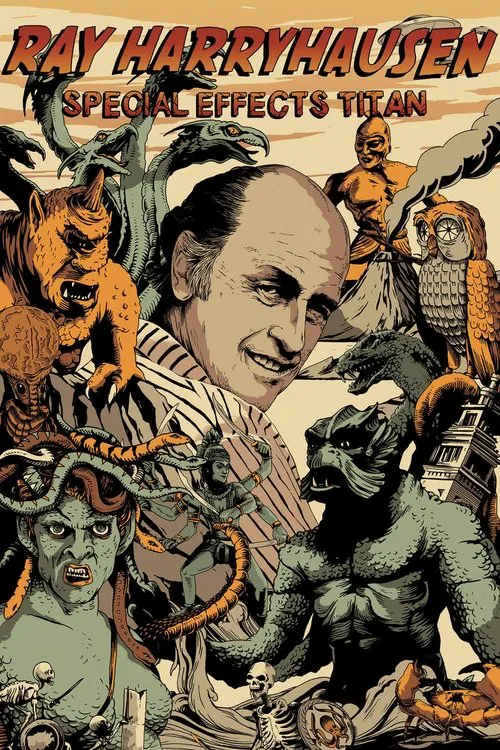Ray Harryhausen: Special Effects Titan

Plot
Ray Harryhausen was one of the most influential and iconic special effects masters of all time. Born on June 29, 1920, in Los Angeles, California, Harryhausen's fascination with special effects began at a tender age. His father, a set decorator, brought home stop-motion models for Harryhausen to experiment with. Little did he know that this early fascination would eventually propel him to become a pioneer in the world of stop-motion animation. The film Ray Harryhausen: Special Effects Titan delves into the life and career of this cinematic legend, showcasing his incredible journey from humble beginnings to global recognition. The documentary features extensive interviews with Harryhausen himself, providing firsthand insights into the creative processes and challenges he faced throughout his illustrious career. Supplementing these personal accounts are testimonials from some of the industry's most esteemed professionals who have been directly influenced by Harryhausen's work. One of the most significant aspects of the film is its focus on Harryhausen's early days. Growing up, he spent countless hours crafting intricate mechanical models, driven by a vision that went beyond the conventional filmmaking techniques of his time. With the help of his parents and later his mentor, Willis H. O'Brien, a pioneering special effects artist, Harryhausen honed his skills and eventually landed an opportunity to work on his first animated short film, The Tortoise and the Hare, in 1946. Harryhausen's subsequent collaboration with O'Brien resulted in the groundbreaking animated epic, Mighty Joe Young, released in 1949. This film featured a groundbreaking combination of full live-action and stop-motion animation, a concept Harryhausen would continue to perfect throughout his career. The success of Mighty Joe Young catapulted Harryhausen to prominence, setting the stage for a series of innovative and imaginative projects. The film delves into some of Harryhausen's most iconic works, including Jason and the Argonauts (1963), The 7th Voyage of Sinbad (1958), and One Million Years B.C. (1966). Each of these films is highlighted for its groundbreaking use of stop-motion animation and their enduring impact on the fantasy and adventure genres. Jason and the Argonauts, in particular, showcased Harryhausen's mastery of the medium with his iconic skeletons, whose mesmerizing dance was a highlight of the film. One Million Years B.C., an adaptation of the 1912 novel by Marie Corelli, was another high point in Harryhausen's career. While the film was criticized by some for its perceived sexism, its visual style and use of stop-motion animation have been widely acclaimed. Many consider the film's portrayal of the cave girl Raquel to be one of the most influential depictions of the female species in early 20th-century science fiction. Raquel's role in the narrative remains one of the standout aspects of the film. The documentary also explores some of the challenges Harryhausen faces in his creative journey. Working outside the studio system, he encountered numerous difficulties from financing to censorship. Despite these setbacks, Harryhausen persevered, driven by an unwavering commitment to his craft and a sense of responsibility to push the boundaries of animation. The influence of Harryhausen's work transcends generations and geographical boundaries. As mentioned, some of the world's most celebrated filmmakers have been drawn to his style. Peter Jackson, director of The Lord of the Rings trilogy, has cited Harryhausen as a primary influence. Terry Gilliam, a renowned director and animator, has spoken highly of Harryhausen's innovative approach to animation. Guillermo del Toro, an acclaimed director, has praised Harryhausen's use of imagination in his films. Unseen footage recently uncovered also features prominently in the documentary, highlighting Harryhausen's tireless experimentations and trials. From elaborate battle scenes to experimental sequences featuring early robotics, the unseen footage showcases Harryhausen's unwavering dedication to exploring the limits of animation. As the film comes full circle, we find Harryhausen reflecting on his career, its triumphs and setbacks, and its lasting impact on the world of cinema. The testament of his contemporaries and successors is clear – Harryhausen's innovative approach to animation, combined with his unwavering passion and dedication, has left an indelible mark on the film industry. As his peers would attest, Ray Harryhausen was a titan of the cinematic world, pushing the boundaries of what was thought possible. His life's work has inspired generations of animators and filmmakers, forever changing the landscape of visual storytelling.
Reviews
Recommendations



